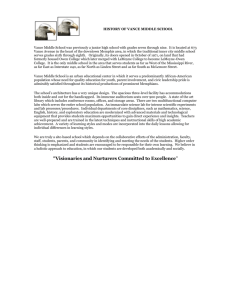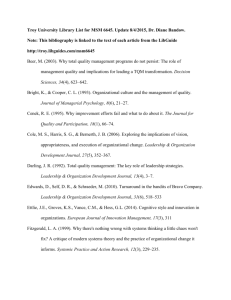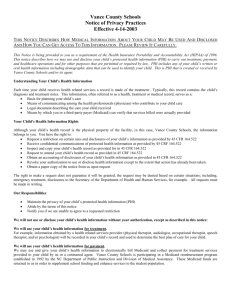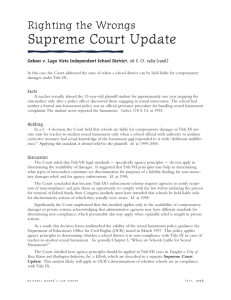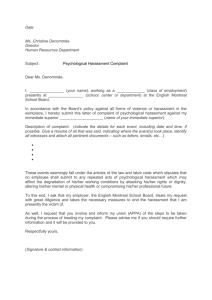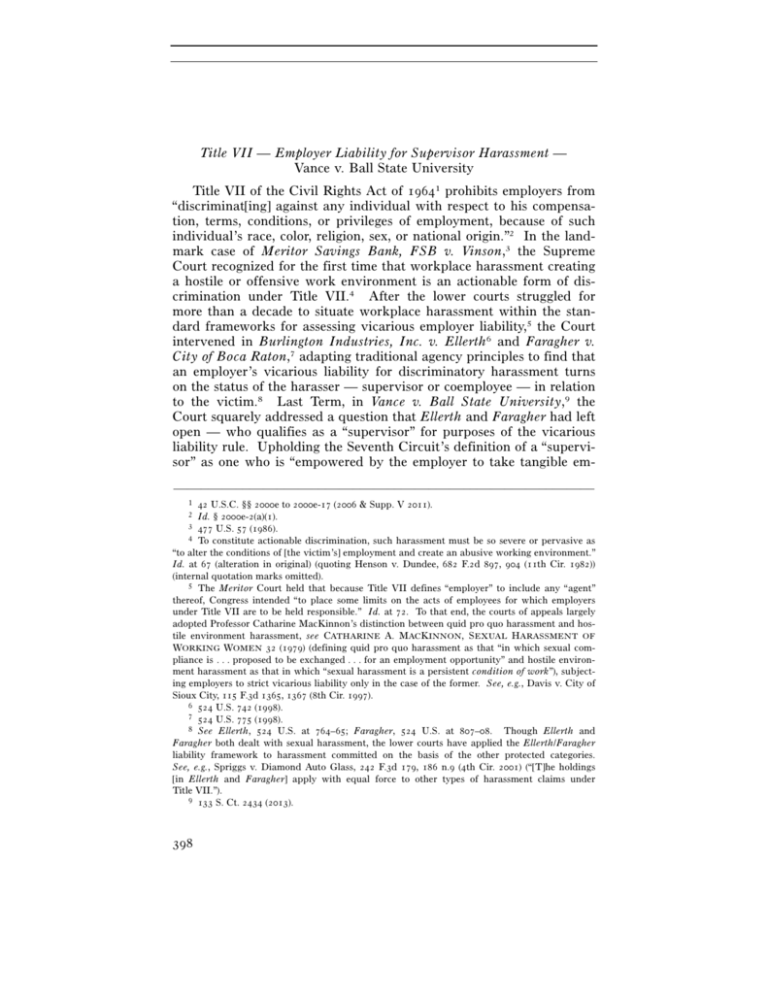
Title VII — Employer Liability for Supervisor Harassment —
Vance v. Ball State University
Title VII of the Civil Rights Act of 19641 prohibits employers from
“discriminat[ing] against any individual with respect to his compensation, terms, conditions, or privileges of employment, because of such
individual’s race, color, religion, sex, or national origin.”2 In the landmark case of Meritor Savings Bank, FSB v. Vinson,3 the Supreme
Court recognized for the first time that workplace harassment creating
a hostile or offensive work environment is an actionable form of discrimination under Title VII.4 After the lower courts struggled for
more than a decade to situate workplace harassment within the standard frameworks for assessing vicarious employer liability,5 the Court
intervened in Burlington Industries, Inc. v. Ellerth6 and Faragher v.
City of Boca Raton,7 adapting traditional agency principles to find that
an employer’s vicarious liability for discriminatory harassment turns
on the status of the harasser — supervisor or coemployee — in relation
to the victim.8 Last Term, in Vance v. Ball State University,9 the
Court squarely addressed a question that Ellerth and Faragher had left
open — who qualifies as a “supervisor” for purposes of the vicarious
liability rule. Upholding the Seventh Circuit’s definition of a “supervisor” as one who is “empowered by the employer to take tangible em–––––––––––––––––––––––––––––––––––––––––––––––––––––––––––––
1
2
3
4
42 U.S.C. §§ 2000e to 2000e-17 (2006 & Supp. V 2011).
Id. § 2000e-2(a)(1).
477 U.S. 57 (1986).
To constitute actionable discrimination, such harassment must be so severe or pervasive as
“to alter the conditions of [the victim’s] employment and create an abusive working environment.”
Id. at 67 (alteration in original) (quoting Henson v. Dundee, 682 F.2d 897, 904 (11th Cir. 1982))
(internal quotation marks omitted).
5 The Meritor Court held that because Title VII defines “employer” to include any “agent”
thereof, Congress intended “to place some limits on the acts of employees for which employers
under Title VII are to be held responsible.” Id. at 72. To that end, the courts of appeals largely
adopted Professor Catharine MacKinnon’s distinction between quid pro quo harassment and hostile environment harassment, see CATHARINE A. MACKINNON, SEXUAL HARASSMENT OF
WORKING WOMEN 32 (1979) (defining quid pro quo harassment as that “in which sexual compliance is . . . proposed to be exchanged . . . for an employment opportunity” and hostile environment harassment as that in which “sexual harassment is a persistent condition of work”), subjecting employers to strict vicarious liability only in the case of the former. See, e.g., Davis v. City of
Sioux City, 115 F.3d 1365, 1367 (8th Cir. 1997).
6 524 U.S. 742 (1998).
7 524 U.S. 775 (1998).
8 See Ellerth, 524 U.S. at 764–65; Faragher, 524 U.S. at 807–08. Though Ellerth and
Faragher both dealt with sexual harassment, the lower courts have applied the Ellerth/Faragher
liability framework to harassment committed on the basis of the other protected categories.
See, e.g., Spriggs v. Diamond Auto Glass, 242 F.3d 179, 186 n.9 (4th Cir. 2001) (“[T]he holdings
[in Ellerth and Faragher] apply with equal force to other types of harassment claims under
Title VII.”).
9 133 S. Ct. 2434 (2013).
398
2013]
THE SUPREME COURT — LEADING CASES
399
ployment actions against the victim,”10 the Court rejected the more
expansive definition favored by the Equal Employment Opportunity
Commission (EEOC) and the dissent,11 according to which a “supervisor” is authorized to undertake or recommend tangible employment
decisions or to direct the employee’s daily work activities.12 The Court
had previously held that Congress intended the Court to look to traditional agency principles for guidance in formulating vicarious liability
rules under Title VII.13 Notably, however, the Court’s choice of definition in Vance was largely unmoored from such principles. In particular, both the majority and the dissent neglected an area of agency
law that bears on the question of supervisory status in the context of
vicarious employer liability: the superior-servant exception to the
fellow-servant rule. Had the Court engaged with the common law in
this area, it would have found an approach more in keeping with the
Vance dissent.
Maetta Vance, an African American server and catering assistant
employed by Ball State University’s Dining Services, filed a series of
internal harassment complaints against several Ball State employees
beginning in 2005.14 Among her various complaints, Vance alleged
that Saundra Davis, a white woman in her department, addressed her
in a threatening manner on two occasions (including one incident
where she asked Vance, “Are you scared?” while affecting a Southern
accent) and that Davis stood by and laughed while Davis’s husband
and daughter taunted Vance with racial slurs.15 Dissatisfied with Ball
State’s response to her complaints, Vance filed suit against the university in 2006 in the United States District Court for the Southern District of Indiana and alleged, inter alia, “that she had been subjected to
a racially hostile work environment” by Davis, her purported supervisor, in violation of Title VII.16
The district court granted Ball State’s motion for summary judgment and concluded that because Davis had no authority to “hire, fire,
demote, promote, transfer, or discipline” Vance,17 she was not her supervisor and thus Ball State could not be held vicariously liable for the
–––––––––––––––––––––––––––––––––––––––––––––––––––––––––––––
10
11
12
Id. at 2439.
Id. at 2443.
EEOC Enforcement Guidance: Vicarious Employer Liability for Unlawful Harassment by
Supervisors, EEOC Compl. Man. (CCH) ¶ 3116, at 3249 (June 18, 1999) [hereinafter EEOC
Guidance].
13 See Meritor Sav. Bank, FSB v. Vinson, 477 U.S. 57, 72 (1986).
14 Vance, 133 S. Ct. at 2439.
15 Vance v. Ball State Univ., No. 1:06-cv-1452-SEB-JMS, 2008 WL 4247836, at *2, *5, *8
(S.D. Ind. Sept. 10, 2008). Davis filed a complaint of her own, alleging that Vance referred to her
as “an evil fucking bitch” and splattered her with gravy. Id. at *2, *8.
16 Vance, 133 S. Ct. at 2440.
17 Vance, 2008 WL 4247836, at *12 (quoting Hall v. Bodine Elec. Co., 276 F.3d 345, 355 (7th
Cir. 2002)).
400
HARVARD LAW REVIEW
[Vol. 127:398
alleged harassment.18 Under the Ellerth and Faragher framework, an
employer’s liability depends on the status of the harassing employee.
When the harasser is the victim’s coemployee, the employer is held to
a negligence standard.19 But when the harasser is the victim’s supervisor, the employer is subject to vicarious liability. If such harassment
culminates in a tangible employment action — including such acts as
“firing, failing to promote, reassignment with significantly different responsibilities, or a decision causing a significant change in benefits”20 — the employer is strictly liable. If the harassment does not
culminate in a tangible employment action, then the employer can
avoid liability only by showing: (1) that it exercised reasonable care “to
prevent and correct promptly” the harassment and (2) that the plaintiff
“unreasonably failed to take advantage of any preventive or corrective
opportunities” that the employer provided.21 The Seventh Circuit affirmed the district court’s decision, holding that even if Davis had the
authority to “tell [Vance] what to do,” Davis was not Vance’s supervisor because the Seventh Circuit had “not joined other circuits in holding that the authority to direct an employee’s daily activities establishes supervisory status.”22
The Supreme Court affirmed. Writing for the majority, Justice
Alito23 began by rejecting Vance’s contention that her preferred definition of “supervisor” accorded better with the commonplace understanding of supervisory status and its definition in other legal contexts.24 Observing that the term “lacks a sufficiently specific meaning”
in ordinary usage and that its meaning varies considerably across different statutes,25 he concluded that any proposed definition for purposes of Title VII should be judged according to its ability to “fit[]
within the highly structured framework” of Ellerth and Faragher.26
Proceeding with that inquiry, Justice Alito argued that the Seventh
Circuit’s definition was consistent with the Court’s characterization of
the status of the alleged harassers in Ellerth and Faragher. He granted
that the authority to direct an employee’s daily tasks might assist the
harasser in achieving his discriminatory ends. But because “most
–––––––––––––––––––––––––––––––––––––––––––––––––––––––––––––
18
19
See id.
See Burlington Indus., Inc. v. Ellerth, 524 U.S. 742, 759 (1998); Faragher v. City of Boca
Raton, 524 U.S. 775, 799 (1998); see also Vance, 2008 WL 4247836, at *14.
20 Ellerth, 524 U.S. at 761.
21 Id. at 765; Faragher, 524 U.S. at 807–08.
22 Vance v. Ball State Univ., 646 F.3d 461, 470 (7th Cir. 2011).
23 Justice Alito was joined by Chief Justice Roberts and Justices Scalia, Kennedy, and Thomas.
Justice Thomas also wrote a brief concurrence stating that although he believed that Ellerth and
Faragher were wrongly decided, he had joined the majority opinion because it “provide[d] the
narrowest and most workable rule.” Vance, 133 S. Ct. at 2454 (Thomas, J., concurring).
24 Id. at 2444 (majority opinion).
25 Id.
26 Id. at 2446.
2013]
THE SUPREME COURT — LEADING CASES
401
workplace tortfeasors are aided in accomplishing their tortious objective by the existence of the agency relation,” the harasser’s reliance on
such assistance is not sufficient to establish vicarious liability.27
Pointing to language in Ellerth identifying supervisors as “a distinct
class of agent” empowered “to make economic decisions affecting other
employees under his or her control,”28 Justice Alito drew the implication that “the authority to take tangible employment actions is the defining characteristic of a supervisor.”29 He then noted that because the
Ellerth/Faragher rule was meant to be “workable” and to incorporate
both the interests of employers and employees, the definition of “supervisor” the Court had adopted — “one that can be readily applied” — was preferable to the EEOC’s.30 The vagueness of the
EEOC’s alternative definition, he argued, was reflected in the fact that
Vance and the Government disagreed over whether Davis actually satisfied it.31 By contrast, the Court’s standard would make it easier to
resolve the issue of supervisory status as a matter of law and would
present juries with a simpler inquiry.32
Justice Alito rejected the dissent’s suggestion that the more restrictive definition would shield employers from liability, noting that they
would still be held to a negligence standard in the case of a nonsupervisory harasser.33 He further argued that the dissent’s standard, which
effectively presupposed a “highly hierarchical management structure,”
was out of touch with the reality of the modern workplace.34 Responding to various real-world examples of workplace harassment on
which the dissent relied, Justice Alito doubted that the outcome in
those cases would turn on the supervisory status of the harassers.35
Finally, with respect to the case at hand, Justice Alito held that Davis
was not Vance’s supervisor and that there was “no evidence” that
Davis would satisfy even the more liberal EEOC standard.36
Justice Ginsburg dissented.37 She began by arguing that the
majority’s standard failed to accord with the Court’s precedent. In
Faragher, for instance, the Court had characterized one of the harassers as a supervisor even though there was no evidence that his au–––––––––––––––––––––––––––––––––––––––––––––––––––––––––––––
27 Id. at 2447–48 (quoting Burlington Indus., Inc. v. Ellerth, 524 U.S. 742, 760 (1998)) (internal
quotation marks omitted).
28 Id. at 2448 (emphasis omitted) (quoting Ellerth, 524 U.S. at 762).
29 Id.
30 Id. at 2449.
31 Id.
32 Id. at 2450.
33 Id. at 2451.
34 See id. at 2452 (observing that in many “modern organizations . . . it is common for employees to have overlapping authority with respect to the assignment of work tasks”).
35 Id. at 2452–53.
36 Id. at 2453–54.
37 Justice Ginsburg was joined by Justices Breyer, Sotomayor, and Kagan.
402
HARVARD LAW REVIEW
[Vol. 127:398
thority extended beyond assigning and overseeing daily work tasks.38
Several years later, the Court treated as supervisors a group of employees who lacked the authority to discharge and demote the victim
but oversaw the day-to-day operations of her workplace.39 Justice
Ginsburg noted that in each instance the Court had rested its determination on a uniform premise: a superior had “t[aken] advantage of the
power vested in [him]” as an agent of the employer.40 To “fortify [her]
conclusion,” Justice Ginsburg proceeded to describe the facts of four
real-life examples,41 where in each case “a person vested with authority to control the conditions of a subordinate’s daily work life used his
position to aid his harassment.”42 Under the Court’s restrictive definition, Justice Ginsburg argued, none of those cases could give rise to vicarious liability.43 The EEOC’s standard, on the other hand, aptly encompassed such cases and was owed Skidmore deference.44
Justice Ginsburg then questioned the majority’s claim to simplicity
and administrability, noting that Justice Alito’s frequent hedging and
qualifying revealed a standard appreciably more intricate and factintensive than the majority suggested.45 For instance, the Court included as “supervisors” at least some of those employees whose authority is limited to recommending a tangible employment decision.46 In
addition, an individual who has the authority to reassign an employee
in a way that has possible economic consequences (such as “foreclosing . . . eligibility for promotion”) might also qualify as a “supervisor.”47 Such hedging prompted Justice Ginsburg to question “just how
‘clear’ and ‘workable’ the Court’s definition is.”48
Justice Ginsburg predicted that the Court’s definition of “supervisor” will “hinder efforts to stamp out discrimination in the workplace.”49 While she agreed that Davis probably would not qualify as
–––––––––––––––––––––––––––––––––––––––––––––––––––––––––––––
38 Vance, 133 S. Ct. at 2457–58 (Ginsburg, J., dissenting). The plaintiff in Faragher alleged
that a lower-level supervisor had threatened her with yearlong toilet-cleaning duties unless she
submitted to his advances. See id. at 2457.
39 Id. at 2458 (citing Pa. State Police v. Suders, 542 U.S. 129, 140 (2004)).
40 Id.
41 Id. at 2459–60.
42 Id. at 2460.
43 Id.
44 Id. at 2461.
45 Id. at 2462–63.
46 See id. at 2446 (majority opinion) (noting that a supervisor’s authority to take tangible employment actions may be subject to “ministerial approval”); id. at 2446 n.8 (“[T]angible employment actions can be subject to . . . approval [by higher management].”); id. at 2452 (noting that an
employer who delegates authority to take tangible employment actions to a small, centralized
group of employees “may be held to have effectively delegated the power to take tangible employment actions to the employees on whose recommendations it relies”).
47 Id. at 2447 n.9.
48 Id. at 2462 (Ginsburg, J., dissenting).
49 Id. at 2464.
2013]
THE SUPREME COURT — LEADING CASES
403
Vance’s supervisor even under the EEOC standard,50 she criticized the
majority for placing the burden of proving employer negligence on victims of harassment whenever their harasser “lacks the power to take
tangible employment actions.”51 Such a result is particularly troubling,
in Justice Ginsburg’s view, because vicarious liability serves to incentivize employers to “provide preventative instruction” to employees.52
She concluded by inviting Congress to intervene in correcting the
Court’s error,53 just as she had done six years earlier in Ledbetter v.
Goodyear Tire & Rubber Co.54
Both the majority and the dissent acknowledged the importance of
looking to agency law for guidance in formulating vicarious liability
rules under Title VII.55 But neither mentioned an agency law principle that offers relevant guidance: the superior-servant exception to the
fellow-servant rule, the rule that limited employers’ liability for injuries to a worker caused by the negligence of a coworker prior to the
adoption of workers’ compensation laws.56 Had the Court examined
the exception, it would have found that in most of the states that recognized it, an employee’s status as a superior servant did not depend
on whether that employee had the authority to hire and fire the injured party. Instead, courts looked to the facts and circumstances of
each case to determine whether the tortfeasor had been granted the
power to control the injured employee and whether that control was
implicated in the tort. For this reason, the common law understanding
of superior servants prefigures the dissent’s context-sensitive inquiry,
which asks whether the harassing employee’s authority was “of a sufficient magnitude so as to assist [the employee] . . . in carrying out the
harassment.”57 While the common law is by no means dispositive of
the Court’s choice, it does offer relevant guidance that both sides failed
to address.
Beginning with Meritor, the Court has stressed the importance of
looking to traditional agency principles in determining vicarious employer liability under Title VII: “Congress wanted courts to look to
agency principles for guidance in this area,” even though “such
common-law principles may not be transferable in all their particulars
–––––––––––––––––––––––––––––––––––––––––––––––––––––––––––––
50
51
52
53
54
55
56
Id. at 2465.
Id. at 2464.
Id.
Id. at 2466.
550 U.S. 618, 661 (2007) (Ginsburg, J., dissenting).
See Vance, 133 S. Ct. at 2441; id. at 2455–56 (Ginsburg, J., dissenting).
See generally Comment, The Creation of a Common Law Rule: The Fellow Servant Rule,
1837–1860, 132 U. PA. L. REV. 579 (1984) (tracing the historical genesis of the fellow-servant rule
and the superior-servant exception).
57 Vance, 133 S. Ct. at 2461 (Ginsburg, J., dissenting) (omission in original) (quoting EEOC
Guidance, supra note 12, at 3248) (internal quotation marks omitted).
404
HARVARD LAW REVIEW
[Vol. 127:398
to Title VII.”58 To that end, the Court in Ellerth and Faragher invoked and adapted the “master-servant” rule embodied in § 219 of the
Restatement (Second) of Agency,59 which provides that a master is
subject to liability for the torts of his servants committed in the scope
of their employment but not for torts committed outside that scope unless, inter alia, the servant “was aided in accomplishing the tort by the
existence of the agency relation.”60
In relying on § 219 for guidance, however, the Court in Ellerth and
Faragher ignored the fact that beginning in the mid-nineteenth century, courts rejected the master-servant rule when employees were injured by their coworkers.61 Under the fellow-servant rule, which became “firmly entrenched in nearly every American jurisdiction” by
1880,62 an employee could not recover against his employer for injuries
caused by the negligence of a coworker arising out of the scope of the
tortfeasor’s employment.63 But as the fellow-servant rule became settled law across the nation, some states recognized an exception to employer immunity when the tortfeasor was a servant who had been
granted the authority to control other servants and the tort arose out
of that control. This rule — known as the superior-servant or viceprincipal exception — was adopted in one form or another by courts in
at least twenty-two states at various times from the mid-nineteenth to
the early twentieth centuries,64 before the common law of workplace
injury was supplanted by state workers’ compensation statutes.65
–––––––––––––––––––––––––––––––––––––––––––––––––––––––––––––
58
59
Meritor Sav. Bank, FSB v. Vinson, 477 U.S. 57, 72 (1986).
Burlington Indus., Inc. v. Ellerth, 524 U.S. 742, 758–60 (1998); Faragher v. City of Boca
Raton, 524 U.S. 775, 797 (1998).
60 RESTATEMENT (SECOND) OF AGENCY § 219(2)(d) (1957).
61 Comment, supra note 56, at 579.
62 Id.
63 For the leading case, see Farwell v. Boston & Worcester Railroad Corp., 45 Mass. (4 Met.)
49 (1842).
64 See FRANCIS M. BURDICK, THE LAW OF TORTS 208–09 (3d ed. 1913) (collecting cases
from fifteen states: Arkansas, Georgia, Illinois, Kansas, Kentucky, Louisiana, Missouri, Nebraska,
North Carolina, Ohio, South Carolina, Tennessee, Texas, Utah, and Washington). Subsequent to
the publication of this treatise, Oklahoma began recognizing the exception. See Ardmore Oil &
Milling Co. v. Barner, 179 P. 932, 934 (Okla. 1919). Other states adopted a more restricted version
of the exception, holding employers vicariously liable when an employee was injured in connection with a risk, not incident to his employment, imposed on him by a superior servant with authority to control his work. See 4 C. B. LABATT, COMMENTARIES ON THE LAW OF MASTER
AND SERVANT 3994–98 (1913) (collecting cases from six states: Colorado, Indiana, Michigan,
Rhode Island, Vermont, and Virginia).
65 See generally Richard A. Epstein, The Historical Origins and Economic Structure of Workers’ Compensation Law, 16 GA. L. REV. 775 (1982). Workers’ compensation statutes, adopted in
every state by 1948, “fundamentally altered” the law of workplace injury by, inter alia, abolishing
the fellow-servant rule for covered employees. Lawrence M. Friedman & Jack Ladinsky, Social
Change and the Law of Industrial Accidents, 67 COLUM. L. REV. 50, 70 (1967). Nonetheless, the
fellow-servant rule continues to have some viability in industries (typically farming) not covered
by the state’s workers’ compensation statute. See 27 AM. JUR. 2D Employment Relationship
2013]
THE SUPREME COURT — LEADING CASES
405
Notably, most of the states that recognized the superior-servant exception held that an employee’s status as a superior servant did not
depend on whether that employee had the authority to hire or discharge the injured party.66 Indeed, according to a treatise published in
1907, Texas was alone in requiring such authority.67 The following
principle emerges from the clear thrust of these cases: where an em–––––––––––––––––––––––––––––––––––––––––––––––––––––––––––––
§ 343 (2004). But see Michael J. Phillips, Employer Sexual Harassment Liability Under Agency
Principles: A Second Look at Meritor Savings Bank, FSB v. Vinson, 44 VAND. L. REV. 1229, 1252
n.132 (1991) (observing that the fellow-servant rule is “looked upon with disfavor by courts even
when it still might apply”).
66 See, e.g., Illinois: Wilson v. Counsell, 182 Ill. App. 79, 82–85 (1913) (holding that an employee with authority to direct injured employees “as to all matters relating to the manner in which
the work should be done, and what work should be done,” id. at 84, but with “no power to hire or
discharge,” id. at 82, qualified as a superior servant or vice principal); Kansas: Atchison & E.
Bridge Co. v. Miller, 80 P. 18, 24 (Kan. 1905) (“[W]henever the master delegates to any officer,
servant, agent, or employé, high or low, the performance of any of the duties above mentioned [all
involving the provision of a safe work environment] . . . then such officer, agent, or employé
stands in the place of the master, . . . and the master is liable for his acts or his negligence . . . .”
(quoting Atchison, T. & S. F. R. Co. v. Moore, 29 Kan. 632, 644 (1883))); Louisiana: Evans v. La.
Lumber Co., 35 So. 736, 738 (La. 1903) (“[T]he master is liable when the work in which he is employed requires that one of the employés shall have the direction and control of the servant placed
under him, although he may not have the independent power . . . to employ and discharge.”);
Missouri: Smith v. Am. Car & Foundry Co., 99 S.W. 790, 791 (Mo. Ct. App. 1907) (“There is no
ironclad rule by which to determine [whether an employee is a fellow servant or a vice principal].
Its solution does not depend upon [the employee’s] rank, his power to hire and discharge
employés, or the fact that he occasionally worked with the men, but upon the authority, if any, he
had over the workmen, and their duty to obey his orders and follow his directions . . . .”);
Nebraska: Union Pac. Ry. Co. v. Doyle, 70 N.W. 43, 46 (Neb. 1897) (“[N]or does it follow that one
employé is not a vice principal, as to his co-employés, because he is not vested with authority to
hire and discharge them. The most satisfactory evidence that one is, as to his co-employés, a vice
principal, is that his co-employés are under his supervision and his control, — subject to his order
and direction.”); North Carolina: Lamb v. Littman, 44 S.E. 646, 647 (N.C. 1903) (noting that “[i]t
is not absolutely necessary for a vice principal to have the authority to hire and discharge” so long
as the employee reasonably believes that failure to comply with his superior’s orders will result in
discharge); Oklahoma: Barner, 179 P. at 934 (“[I]f it were a fact that he never employed any laborer and never discharged any, and had no authority to hire or discharge any, or that he was forbidden to exercise any such authority, the fact remains undisputed that he was foreman of the work
in charge and directed the manner of the work, and that the master itself, the milling company,
spoke through him in giving directions to the laborers.”); Rhode Island: Hanna v. Granger, 28 A.
659, 660 (R.I. 1894) (“[A] servant is a vice principal only when he stands in place of the principal
with reference to the principal’s duty [to ensure workplace safety], or in the exercise of the principal’s functions.”); Washington: O’Brien v. Page Lumber Co., 82 P. 114, 115 (Wash. 1905) (“It is
true there is no evidence that the sawyer had power to hire men or to discharge them except as
above stated; but we held . . . that ‘the power of superintendence and control is the test’ in such
cases.” (quoting Allend v. Spokane Falls & N. Ry. Co., 58 P. 244, 248 (Wash. 1899))).
67 J. Breckinridge Robertson & Clark A. Nichols, Master and Servant, in 26 CYCLOPEDIA
OF LAW AND PROCEDURE 941, 1308 n.50 (William Mack ed., 1907) (“In [Texas] the rule is different from that in any other state in that a superior servant is a fellow servant unless he has the
power to employ and discharge the injured servant.”). North Carolina, although not requiring
that superior servants have the power to discharge, did require that the injured employee reasonably believe that failure to comply with the superior’s orders would result in discharge. See
Lamb, 44 S.E. at 647.
406
HARVARD LAW REVIEW
[Vol. 127:398
ployer’s vicarious liability depends on the tortfeasor’s “superior” status,
as defined in relation to the injured employee,68 that status does not
depend on the tortfeasor’s having the authority to hire or discharge the
injured employee.
What mattered, according to courts applying the exception, was
whether the tortfeasor had employer-conferred control over the injured
employee and whether that control was implicated in the tort. Allend
v. Spokane Falls & Northern Railway Co.69 provides an illustrative
example. A railway laborer sustained injuries in an explosion allegedly caused by the negligence of his foreman, who had been vested with
the “power to direct his work, labor, and movements.”70 The court
found that the employer, by granting the foreman the power to direct
and control the employee, had effectively offloaded its duty “to provide
a reasonably safe place in which the respondent was to work.”71 For
this reason, the employer was vicariously liable for the foreman’s torts
committed in the exercise of his supervisory authority, even though the
foreman lacked the authority “to discharge or employ workmen.”72
The court’s reasoning bears a notable resemblance to Justice
Ginsburg’s in Vance, who for purposes of vicarious liability in the harassment context would look to the harasser’s “authority to control the
conditions of a subordinate’s daily work life” and whether the harasser
used that control “to aid his harassment.”73
In addition, courts applying the superior-servant exception typically relied on context, not bright-line rules, to determine whether an employee qualified as a superior servant.74 This fact-intensive inquiry
–––––––––––––––––––––––––––––––––––––––––––––––––––––––––––––
68 Some jurisdictions recognized versions of the superior-servant or vice-principal exception
but did not define the status of “superior servant” or “vice principal” in relation to the injured
employee. In Northern Pacific Railroad Co. v. Peterson, for instance, the Supreme Court held
that “the person whose neglect caused the injury must be ‘one who was clothed with the control
and management of a distinct department . . . .’” 162 U.S. 346, 355 (1896) (quoting Balt. & Ohio
R.R. Co. v. Baugh, 149 U.S. 368, 381 (1893)). But this decision has little relevance to Vance. For
one, because Peterson involved the creation of general federal common law before Erie Railroad
Co. v. Tompkins, 304 U.S. 64 (1938), the case now stands as one source of guidance rather than
binding precedent. See 19 CHARLES ALAN WRIGHT, ARTHUR R. MILLER & EDWARD H.
COOPER, FEDERAL PRACTICE AND PROCEDURE § 4518 (2d ed. 1996). In addition, the
Peterson holding offers no guidance in resolving the central dispute in Vance since Justices Alito
and Ginsburg agreed that supervisory status must be defined in relation to the injured employee.
69 58 P. 244.
70 Id. at 244.
71 Id. at 248.
72 Id.
73 Vance, 133 S. Ct. at 2460 (Ginsburg, J., dissenting).
74 See, e.g., Jolly v. Smith, 65 S.W.2d 908, 909 (Ark. 1933) (noting that the vice-principal exception is “wholly dependent upon the facts and circumstances in each particular case”); Radtke v. St.
Louis Basket & Box Co., 129 S.W. 508, 515 (Mo. 1910) (noting that under Illinois law, the question
of whether an employee acted as a fellow servant or vice principal is “a question for the jury to
decide from all the circumstances of the case”); Union Pac. Ry. Co. v. Doyle, 70 N.W. 43, 44 (Neb.
1897) (“Whether one of several employés of the same master is a vice principal . . . is a mixed
2013]
THE SUPREME COURT — LEADING CASES
407
seems to prefigure the Vance dissent’s preferred approach to determining supervisory status under Title VII. Noting that the question of supervisory status is “not susceptible to mechanical rules and on-off
switches,”75 Justice Ginsburg argued that the answer “depends on a
constellation of surrounding circumstances, expectations, and relationships”76 and that “context is often key.”77
To be sure, the superior-servant exception contemplates negligent
acts whereas harassment is an intentional tort. But that limitation
says less about the inner logic of the superior-servant exception and
more about its role under traditional common law: an exception to the
fellow-servant rule, which itself was framed in terms of negligence.78
The theoretical basis for the superior-servant exception, however, does
not depend in any deep sense on a determination of negligence: what
matters is whether the tort arises out of the tortfeasor’s authorized
control over the details of the injured employee’s work, control that is
the touchstone of the master-servant relationship.79
Of course, nothing in the common law pertaining to the superiorservant exception compels a choice of definition in Vance. For one, the
superior-servant exception contemplates acts arising out of the scope of
the tortfeasor’s employment, while harassment arguably falls outside
(or at least not straightforwardly within) that scope.80 More importantly, Congress has directed the Court to look to traditional agency
principles for guidance, not controlling precedent, and those principles
must be considered in tandem with relevant policy concerns.81 Still,
the superior-servant exception provides a useful starting point for
analysis. Had the Court addressed the common law in this area, it
would have found an approach that supports the Vance dissent.
–––––––––––––––––––––––––––––––––––––––––––––––––––––––––––––
question of law and fact; and . . . we are not prepared to lay down any set rule as a test for determining when two or more employés are fellow servants, or one of them a vice principal. The relationship . . . is to be determined by the particular facts and circumstances in evidence . . . .”).
75 Vance, 133 S. Ct. at 2463 (Ginsburg, J., dissenting).
76 Id. (quoting Oncale v. Sundowner Offshore Servs., Inc., 523 U.S. 75, 82 (1998)) (internal
quotation marks omitted).
77 Id. at 2462.
78 See Comment, supra note 56, at 579 (“[The fellow-servant rule] relieved employers of liability for injuries negligently inflicted by any employee upon a ‘fellow servant.’”).
79 See LABATT, supra note 64, at 4204–05 (“[T]he power of controlling the details of the work
to be done is . . . the very element which serves to distinguish one who is, from one who is not, a
master as regards the injured person.”).
80 But see David Benjamin Oppenheimer, Exacerbating the Exasperating: Title VII Liability
of Employers for Sexual Harassment Committed by Their Supervisors, 81 CORNELL L. REV. 66,
141–43 (1995) (arguing that harassment can in fact fall within the scope of one’s employment on
traditional agency principles); see also Susan Estrich, Sex at Work, 43 STAN. L. REV. 813, 855
(1991) (noting that supervisors are responsible for “defin[ing] the acceptable working conditions of
the workplace”).
81 But see Phillips, supra note 65, at 1268 (arguing that policy issues ought to weigh more
heavily than agency principles in this context).

